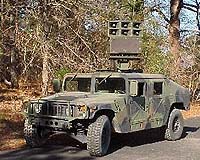 386th ELRS Tests New Humvee Modification
386th ELRS Tests New Humvee Modification
Jul 31, 2008: The 386th Expeditionary Logistics Readiness Squadron's vehicle maintenance section is testing two new modifications for the M1116 up-armored high mobility multipurpose wheeled vehicles' (Humvee) condenser, hoping the improvement will eventually become standard in all M1116 Humvees throughout the U.S. Central Command area of responsibility.
The recent modifications, which were the original brainchild of Tech. Sgt. Paul Gardner from the 386th ELRS, were created in response to a growing problem with the original manufacturer setup and the primary usage of the vehicle in Southwest Asia.
"There hasn't been a day we haven't had at least two Humvees in the shop," said Tech. Sgt. Brandon Bean, vehicle management and analysis NCO. "We've accumulated just more than 100 man hours during the past few weeks on Humvee air-conditioning systems, and spent more than $4,500 in parts."
Not all of the maintenance performed in those 100 hours was on the condenser assembly; the problems with the air-conditioning units of the M1116 Humvee range from replacement of compressors and evaporators to recharging Freon into the air-conditioning systems.
But the condensers represented a significant portion of the shop's repeat maintenance. For every condenser that was fixed, another one or two would come in broken. Additionally, the prior fixes didn't prevent the condensers from becoming broken again, sometimes as quickly as 48 hours later.
"We were getting a new one in every couple of days, with the condensers broken and moving around in the back," said Sergeant Gardner, an Air National Guardsman deployed from the Combat Readiness Training Center in Gulfport, Miss.
The main problem with the original manufacturer design is the design itself; it wasn't created to endure the constant and violent vibrations it receives when Security Forces personnel travel over rugged terrain on patrols 24 hours a day.
"What we're finding is when security forces go outside the gate, the [terrain] they're driving on is like running over a washboard," Sergeant Gardner said. "All the extra vibration is making a lot of things loosen, and the extra impact on the vehicle causes things to break at their weakest points."
The condenser and fan assembly in the M1116 Humvee comes mounted on the rear left side of the vehicle, mounted onto a back fender wall by bolts and a thin piece of sheet metal. Once the assembly begins to vibrate, the sheet metal weakens, leaving the copper lines running alongside susceptible to being punctured or broken.
Oftentimes results in removal of the assembly for repair in the local economy. But for major repairs, the assembly has to be ordered from the manufacturer.
"You can't purchase them here, so we have to order them and wait for them to come in," Sergeant Gardner said. "That can take up to two weeks."
To prevent having to order new condensers because of irreparable damage, Sergeant Gardner's modification involves placing a rubber inner tube between the assembly and sheet metal, in order to help the assembly absorb some of the vibration. Additionally, he constructed a special L-shaped bracket that holds the condenser and fan assembly tighter to the frame.
The modifications consist of two brace configurations: one which bolts down on top of the assembly and another which bolts on the side. For the test phase, the vehicle maintenance section also configured one of the copper tubes most likely to break with a piece of flexible tubing, in order to make it less prone to snapping if the assembly shifts.
In creating the two different test models, Sergeant Gardner hopes to reduce the damage that occurs to the condenser assembly during security forces patrols, as well as make the modification easy to install for other vehicle maintainers in the AOR having the same sort of problem.
"There's not a lot of room to work back there, so I changed the design on the second one so I can just reach in easily and loosen or tighten it," Sergeant Gardner said. "I also wanted to make it as simple as possible, so if it does work I can draw out the measurements and send it to other shops so they can make their own."
For security forces, the end users of the design, the modifications are a welcome change.
"The Humvees themselves are already hot from having the extra armor on them," said Airman 1st Class Julia Berger, 386th Expeditionary Security Forces Squadron. "Without the air conditioning, it makes the heat unbearable for those driving out on patrols."
"We sent two to [vehicle maintenance] last week and they came back with the new modification," Airman Berger said. "They haven't gone down again, so whatever they're doing seems to be working."


















No comments:
Post a Comment